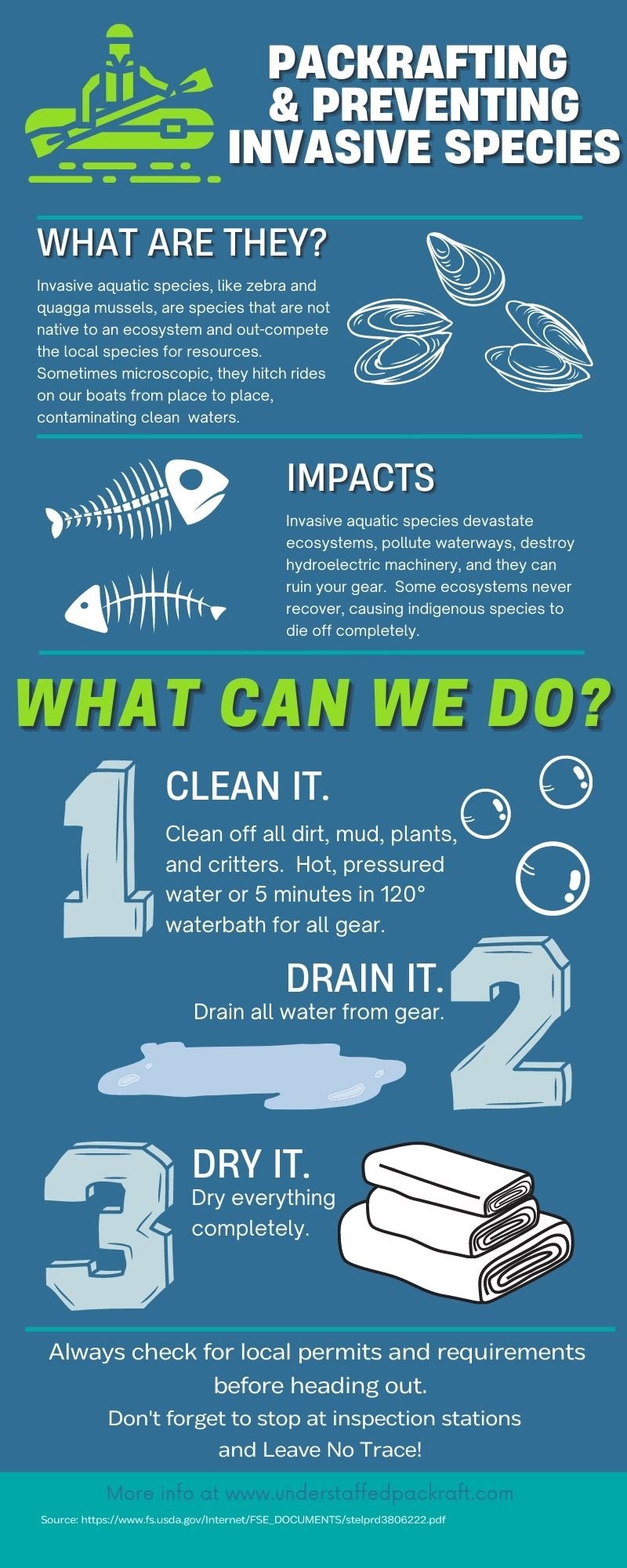Packrafting & Preventing Invasive Species
I don’t like to admit my ignorance all the time, but until I was cruising through Idaho and saw a giant flashing DOT sign “ALL WATERCRAFT MUST STOP”, I was completely oblivious to invasive species inspection stations or anything outside of rec.gov permits. This was definitely ignorant of me, so here’s a fun blog to help you be more informed that my dumb-ass:
Currently, 18 states have some sort of decontamination and inspection program, while 11 states require additional invasive species permits (Otts 2018). Not all states with invasive species regulations currently have invasive aquatic species because their regulations have worked!
Image Source: Montana Public Radio
What are invasive species and why should we care?
Invasive species are species of organisms that are not native to an ecosystem and out-compete the local flora and fauna for resources. When is comes to aquatic invasive species in the United States, zebra and quagga mussels are some of the biggest offenders. These invasive critters hitch rides on our boats, particularly in the seams and folds, and thus spread from one waterway or body of water to the next. Some species are microscopic in their earliest stages, and can grow for days in a pocket of water in an uncleaned boat.
Not every body of water is affected by invasive species because preventions work, but it’s important to research where and to always clean boats thoroughly (see resources below). Did you know some of our favorite outdoor places like Lake Powell, UT and Lake Havasu, AZ are already contaminated?
Decontamination and Inspection Stations
In response to discovering invasive aquatic species in Lake Mead in 2007, several Western States implemented decontamination and inspection stations for all watercraft recreating in state waters (NISIC 2020). Decontamination/Inspection Stations are usually set up on the side of the highway, or at individual launch sites.
Decontamination Stations are at take-outs of contaminated waters and have. hot, pressured water to remove all hitchhikers from the boat. YES! THESE ARE SAFE. FOR PACKRAFTS! New, innovative “dip tanks” are being implemented in Utah to expedite the process and prevent the spread for larger boats.
Inspection Stations are volunteer and state run roadside or ramp-side checkpoints that serve to inspect boats prior to getting into a body water. Most Inspection stations will issues you a tag or receipt- hang on to it, you will need to present this to launch!
Avoiding the Spread of Invasive Species
CLEAN off any mud, plants, and animals from packraft, drysuit, and gear, paying special attention to seams. Hot, high-pressure water or 5 minute soak in a 120° waterbath (Beyers 2011) .
DRAIN all water from packraft and gear.
DRY anything that comes into contact with the water.
Got summer plans or permits? Don’t forget your state boaters registration and invasive species stickers!
California- Quagga Mussels Sticker
Requirements: Quagga Mussels Sticker, boater registration
Fees: $16 Quagga Mussels Sticker, Boater Registration (Separate)
Affected Locations
Colorado- Boat ANS Inspection and Decontamination
Non-motorized inflatable watercraft 10 feet or less in length are exempt.
Affected Locations
Idaho- Invasive Species Boat Stickers
Non-motorized inflatable watercraft 10 feet or less in length are exempt.
Maine- "Preserve Maine Waters" Stickers
Requirements: Preserve Maine Waters (Included with Boater Registration)
Fees: $15 In-State, $45 Out of State (not required in tidal waters)
Montana- Montana Aquatic Invasive Species Prevention Passes
Requirements: Vessel AIS Prevention Pass (AISPP)
Fees: $10 Pass
Nebraska- Aquatic Invasive Species Stamp
Requirements: Resident or Non-Resident Boat AIS Stamp
Fees: $18 Stamp
Nevada- Aquatic Invasive Species Prevention Program
Requirements: Aquatic Invasive Species decal
Fees: $6 non-motorized watercraft
Oregon- Waterway Access and Aquatic Invasive Species Permits
Requirements: Waterway Access Permits for non-motorized craft, Boat Registration
Fees: $7 for 7 days, $19 for 1 year, $32 for 2 year, $22 AIS for out of state
Washington- Aquatic Invasive Species Prevention Permits
Requirements: AISP Permit for Out of State boaters
Fees: $24 AISP Permit
Wyoming- Aquatic Invasive Species Decal
Non-motorized inflatable watercraft 10 feet or less in length are exempt.
Additional Resources
National Invasive Species Information Center (NISIC)
Watercraft Inspection and Decontamination Programs
Inspection Station Contacts by State
Sources:
Beyer, J, Moy, P., and B. DeStasio. 2011. Acute upper thermal limits of three aquatic invasive invertebrates: hot water treatment to prevent upstream transport of invasive species. Environmental Management 47:67-76
Otts, S. 2018. From Theory To Practice: A Comparison Of State Watercraft Inspection And Decontamination Programs To The Model Legal Framework (PDF | 1.08 MB)(link is external) University of Mississippi School of Law, National Sea Grant Law Center.
Schmidt, S. and C. McLane. 2018. 2017 Report on Aquatic Invasive Species Monitoring. Montana Fish, Wildlife and Parks.
Watercraft inspection and decontamination programs. Watercraft Inspection and Decontamination Programs | National Invasive Species Information Center. (n.d.). Accessed March 18, 2022.
Zook, B. and S. Phillips. 2012. Uniform Minimum Protocols and Standards for Watercraft Interception Programs for Dreissenid Mussels in the Western United States (PDF | 2.76 MB) Pacific States Marine Fisheries Commission.




